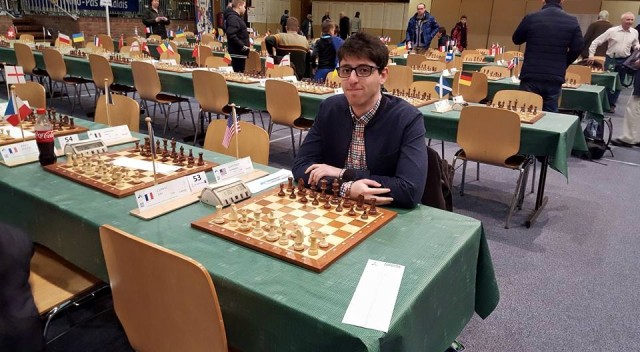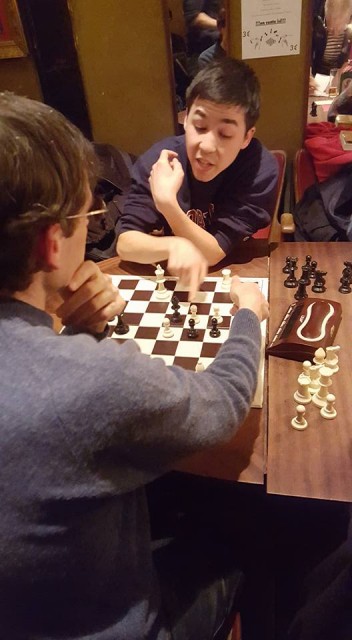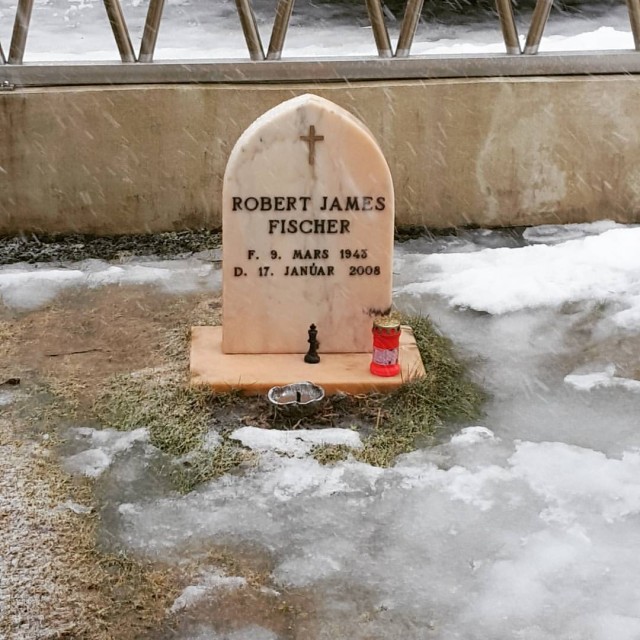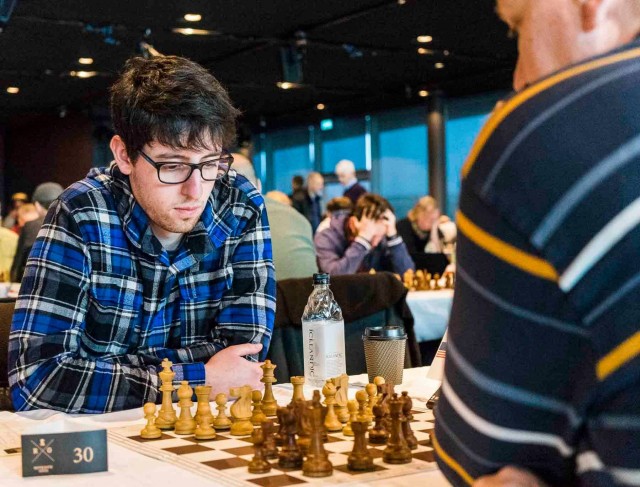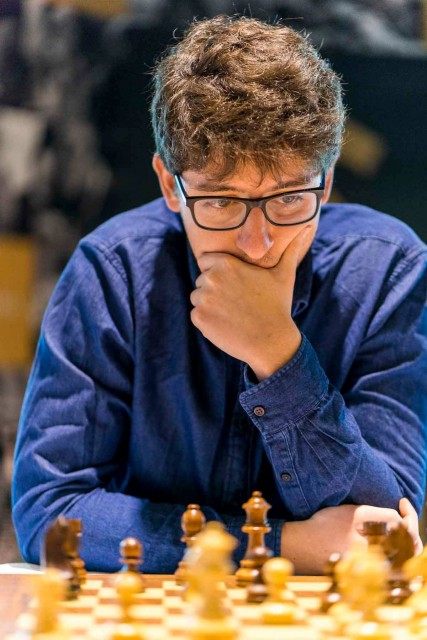There was no real time to reflect on the slight disappointment in Cappelle-la-Grande, as the Cannes Chess Festival was only one day away. Tom (Riccardi) and I took a bus back to Paris and then a high-speed train to the south of France. Upon arrival, it was quickly obvious why Cannes is known for being such a vacation hotspot—the view of the Mediterranean Sea, the beaches, the food, it was all beautiful! We rented an apartment through AirBnb and cooked most of our meals, our go-to staple being farfalle with sausage, mushrooms, onions, and whatever vegetables we could pick up from the grocery store. I also had a lot of Nutella while in France. Like a lot. Tom wouldn’t stop giving me a hard time about it. Cannes The Cannes Chess Festival was run as part of a larger “Festival of Board Games” held at the Palais des Arts, where they hold all the Cannes Festivals (most notably Film, I believe). I joked about feeling slighted that chess was being played in the same room as checkers and scrabble, “childish board games”, of which there were also serious competitions taking place during the week. The tournament was much smaller than Gibraltar or Cappelle but still strong, with Gata Kamsky as the top seed, joined by GMs Danil Dubov and Evgeny Romanov of Russia, and several more GMs and IMs playing. My tournament started poorly with a draw against an expert, failing to convert a winning endgame, but then I bounced back with a quick win and held a draw against GM Kazhgaleyev, who had just defeated me in Cappelle.
But the fate of my tournament took a turn for the worse in the next game, when I lost to FM Thomas O’Sullivan, a French junior who narrowly missed an IM norm in the event. It was hard to feel too upset though, as he did catch me in the opening and then outplayed me as well. I could never quite bounce back in the event, drawing my next two games (two more failed conversions) while playing down. This would be my worst event of the trip by far, but there was a bright spot, as I managed to win an Open Sicilian against FM Bastien Dubessay (France), despite being out-prepared (!) :
[pgn][Event "Cannes Chess Festival 2016"] [Site "?"] [Date "2016.02.26"] [Round "7"] [White "Kavutskiy, Kostya"] [Black "Dubessay, Bastien"] [Result "1-0"] [ECO "B81"] [WhiteElo "2388"] [BlackElo "2295"] [Annotator "Kostya Kavutskiy"] [PlyCount "85"] [EventDate "2016.??.??"] [SourceDate "2016.01.26"] 1. e4 c5 2. Nf3 d6 3. d4 cxd4 4. Nxd4 Nf6 5. Nc3 a6 6. h3 {My favorite move and what I whole-heartedly recommended in Modernized: The Open Sicilian.} e6 7. g4 Be7 8. g5 Nfd7 9. h4 b5 10. a3 Bb7 11. Be3 Nb6 $5 ({Quite recently Karjakin won a very important game in the 2016 Candidates Tournament against Topalov after} 11... O-O {which only reinforced my opinion (expressed in the book) that Black should delay castling for a few more moves and opt to create queenside counterplay as quickly as possible.}) (11... Nc6 {is probably considered the main line here by most Najdorf specialists.}) 12. Rg1 $5 { Played with a bit of regret, since it meant that I had to deviate from my own suggestion M:TOS! After spending a few minutes pondering my options I remembered that GM Surya Ganguly, one of Anand's trusted seconds and a known theoretician, had played Rg1 either in this or a very similar position. Well here my generally hazy memory served me well, for a change!} ({When we (myself and IM Zhanibek Amanov) first started analyzing this line sometime in 2012-13, while it was still largely unexplored, we found that} 12. f4 {looked quite promising for White, who's ready to crack the kingside open with f4-f5, for example 12...N8d7 13.f5 e5 14.Ne6! fxe6 15.Qh5+ Kf8 16.fxe6 +/-. But after running the engine for a while it finally suggested} Na4 $5 {leading to crazy complications after} 13. Nxa4 Bxe4 14. Nxb5 $1 $13 {that only a powerful computer could work out. Not believing this had any relevance to how humans play chess, we took it out of the book, only to be quite surprised when this variation was entered during a high-level game between GMs Oparin and Zhigalko, not long after our book was released! This forced me during the present game to look for other alternatives for White on the 12th move, knowing it was likely that my opponent was well-prepared for these complications.}) 12... N8d7 13. h5 g6 14. Rh1 $6 {Taking control over the h-file, although it's unclear that this will be of any use for White.} ({Critical is} 14. f4 e5 15. Nf3 Qc7 16. Qd2 {as played in Ganguly-Artemiev, Baku 2015, so my memory was somewhat correct!}) 14... Rg8 $6 (14... Rf8 {was better because (I think) the rook isn't hanging on g8 after the critical line following 15.Qg4.}) 15. hxg6 ({ Instead,} 15. Qg4 $1 {would lead to White's advantage:} Ne5 16. Qh3 Nbc4 17. hxg6 hxg6 18. Bxc4 Nxc4 19. Nxe6 $1 {A really powerful sacrifice that one would have to appreciate from afar.} fxe6 20. Qxe6 Rf8 21. Bd4 $1 $40 {and Black is in deep trouble.}) 15... hxg6 16. f4 Na4 $1 {Whoops, I got hit with this resource anyway! Black now wins a pawn and seizes the initiative.} 17. Nxa4 Bxe4 18. Rh7 bxa4 19. Bd3 $1 {The position seems tremendous for Black, who's won a pawn and completely curbed any initiative for White on the kingside. But I felt (somewhat optimistically) that things are not so simple. If I could reach an endgame, Black's a-pawns are really weak, and maybe it won't be so easy to get the rook on g8 into the game. Although objectively Black's advantage here is nearly decisive, I ended up inuiting the future...} Qa5+ 20. Kf2 Bb7 $1 ({I was hoping for} 20... Nc5 21. b4 axb3 22. Nxb3 {and Black is only slightly better after} Qa4 (22... Nxb3 $2 23. Bxe4 $1 d5 24. Bxg6 fxg6 25. cxb3 $16) 23. Nxc5 dxc5 24. Bxe4 Qxe4 25. Qd3 $15) 21. Bc4 Rc8 {Black could also play Nc5, with a decisive advantage.} 22. Ba2 Bd5 23. Bxd5 Qxd5 24. c3 Nc5 25. Qe2 {White has too many weaknesses to survive, but Black's bishop and rook on g8 are still hard to include in the game.} e5 26. Nf3 Nd3+ {Best.} (26... e4 27. Ne1 {and}) (26... exf4 27. Bxc5 Qxc5+ 28. Kg2 {looked somewhat unclear, as White may get some counterplay on the central files.}) 27. Kg2 e4 $6 {Giving away the d4-square to White's bishop, and already it's hard to convert Black's advantage.} ({Easiest was} 27... Qe4 28. Qd2 Rb8 $1 {since} 29. Rb1 {loses to} Nxf4+ 30. Bxf4 Qxb1 $19) 28. Ne1 {If I could just exchange the knights, the strength of my dark-squared bishop would easily compensate for the missing pawn.} Rb8 29. Rd1 Qb7 ({White's potential compensation can be seen after} 29... Qc6 30. Nxd3 exd3+ 31. Qf3 Rxb2+ 32. Kg3 Qxf3+ 33. Kxf3 Rb3 34. Bd4 $1 Rxa3 35. Rxd3 $44 {and White is not worse, despite being two pawns down.}) 30. Rb1 $2 {A tactical blunder.} (30. Nxd3 exd3+ 31. Qf3 Qxb2+ 32. Kg3 $13 {and all three results are very possible, as White threatens Qc6+ and Qd5, for instance.}) 30... Nxe1+ $2 ({I noticed my opponent perk up as he spotted} 30... Qxb2 $1 {and I actually wanted him to play this move, since I thought it didn't work!} 31. Rxb2 Rxb2 32. Nc2 {My intended defense, and the reason Bastien didn't go for this line. But here we both missed} ({We both saw} 32. Bd2 Nxf4+ $19) 32... Rxc2 $1 33. Qxc2 Ne1+ $19) 31. Qxe1 {Now in mutual time trouble I started to feel really optimistic. My dream scenario (Black's bishop and rook on g8 being left out of the game), was awfully close to coming true.} d5 32. Qd1 Qb5 33. Rh1 Qc4 34. Re1 Rh8 $2 {Ironically, as soon as Black retakes the h-file, the tide of the game immediately shifts.} 35. Qd4 $1 { Forcing an endgame that seems difficult for Black.} Qxd4 36. Bxd4 Rh5 37. c4 $1 {Seizing the initiative, as White's pieces flood into the board.} dxc4 $2 {The losing move, Black had to play literally anything else to keep the balance.} ({ Maybe best was} 37... Rb3 38. cxd5 Rbh3 39. Bg1 R3h4 {with enough counterplay, for instance} 40. Rxe4 Rxg5+ $1 $11) 38. Rxe4 Kf8 (38... Kd7 39. Rd1 $18 { Black's king and bishop is in trouble, not to mention the incredibly weak c4, a4, and a6 pawns. Meanwhile White's pawn on b2 is perfectly safe.}) 39. Rbe1 Bd6 40. Bf6 $1 {With just under a minute left on my clock I reached to play Bc3 here, a stable, solid move, but then realized that Bf6 sets up a very straightforward mate on the back rank, effectively ending the game.} Rc8 41. Rd1 {My rooks are ganging up on the d8-square. Amazingly Black's bishop has no good square and the rook on h5 is just an observer, my longtime dream finally appears on the board!} c3 {A last-ditch attempt, but it meets a simple refutation.} (41... Bb8 42. Rxc4 $1 Re8 43. Rxa4 $18 {White wins everything.}) 42. Rxd6 cxb2 (42... c2 {would lose to almost any move--Rc4, Red4, Re1 etc.}) ( 42... Rh1 {is met with} 43. Rc4 $1 $18) 43. Red4 $1 {And it's mate on the back rank no matter what. Black resigned.} (43. Red4 Rc2+ 44. Rd2 Rxd2+ 45. Rxd2 b1=Q 46. Rd8#) 1-0[/pgn]
In the next round I lost to GM Artur Kogan, who played his usual style of enterprising chess and soundly beat me. In the final round I drew against a master in an unmemorable game, finishing with 4.5/9 and a loss of 22 rating points. Tom also had a disastrous tournament, blowing a completely won game against an FM in Round 1 and never recovering, with a few more losses than he’d care to remember. But Marc (Esserman) did quite all right, scoring 6/9 against a tough field, with a key loss coming at the hands of Kamsky in Round 8. The tournament was surprisingly won by GM Bai Jinshi (China), who defeated Dubov and GM Abhijeet Gupta on his way to finish clear first with 7.5/9. Brussels Now that the nightmare in Cannes was over, Tom and I flew to Brussels, as we had a weeklong break before our final event, the Reykjavik Open. In Brussels we stayed with one of my closest friends from my time at Lindenwood University, Elise, who was an extremely generous host. We had a couple of goals for Brussels. One, we wanted to relax and recharge, there were ten more games to be won in Iceland and it was important to show up fresh and excited to play chess. Secondly, we wanted to explore Brussels, and get a bit of culture in during our trip. We saw the world-famous Atomium, had authentic Belgian waffles and fries (mostly known as “french fries”), and developed an intimate understanding of the many, many varieties of Belgian beer. I was amazed by the overall beauty of Brussels, which is filled with rich architecture mixed with a more modern aesthetic.
Somewhat surprisingly, there was quite a fun chess scene in Brussels for amateurs and club players alike, who would often meet up to play blitz during weeknights and weekends at one of several bars throughout the city. Upon discovering the scene Tom and I first tried the ol’ “let’s pretend we’re total beginners but then play at our real strength and crush everyone”, but after a few “brilliancies” the jig was up and we had to confess our ratings. There was even an informal blitz tournament that we crashed on our final day in Brussels. I did well overall but then dropped two games to a couple of players around master strength (no shame in that, especially after downing a few Carolus!). Tom ended up winning the event, going undefeated in all but one game (against yours truly).
We also had the chance to meet up with Frederic, one of my students through Chess.com University, whom I teach monthly in an interactive group class. Frederic took us to one of his favorite cafes in the city where we played a bit, drank more beer (hey, when in Belgium!), and philosophized about chess and life and everything in between. 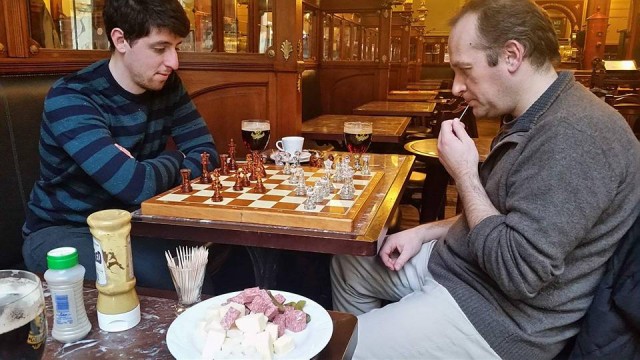 As far as tourism goes, I’d say Brussels was my favorite city to visit. Not as crowded as Paris, but just as visually stunning and full of rich history. But now it was time to get back to business: Iceland. Reykjavik Upon arriving in Iceland we quickly got settled into where we were staying: a large house turned hostel near Downtown Reykjavik. There were about 6-10 people staying there at any given point during the week, so it was interesting to see so many faces come and go in a short period of time. We were really excited to play again in a serious environment; Reykjavik has a reputation for being extremely well-organized, competitive, exciting, and this year was no exception. Like the Cappelle-la-Grande Open, the Reykjavik Open consisted of one big section, ranging from beginners to super-GMs, most notably Shakhriyar Mamedyarov, Dmitry Andreikin, and Richard Rapport, three players I was really star-struck to see play in person. The large section meant one had to do well in the early rounds in order to play against stronger opposition and retain better chances of norming. I would feel obliged to comment on the many Americans playing in Iceland, but Alejandro already did it for me! I won my first game, then got held to two draws while playing down, a bad omen signaling that this was not going to be my tournament either. On the next day, before Round 4, Tom and I and about 50 other players embarked on the Golden Circle Tour, one of the most popular tourist attractions in Iceland. The tour took us on many different sights, including the Gullfoss waterfall, Geysir (one of the world’s largest active geysers), and of course a must-see while in Iceland: the Bobby Fischer Chess Center and grave in Selfoss.
As far as tourism goes, I’d say Brussels was my favorite city to visit. Not as crowded as Paris, but just as visually stunning and full of rich history. But now it was time to get back to business: Iceland. Reykjavik Upon arriving in Iceland we quickly got settled into where we were staying: a large house turned hostel near Downtown Reykjavik. There were about 6-10 people staying there at any given point during the week, so it was interesting to see so many faces come and go in a short period of time. We were really excited to play again in a serious environment; Reykjavik has a reputation for being extremely well-organized, competitive, exciting, and this year was no exception. Like the Cappelle-la-Grande Open, the Reykjavik Open consisted of one big section, ranging from beginners to super-GMs, most notably Shakhriyar Mamedyarov, Dmitry Andreikin, and Richard Rapport, three players I was really star-struck to see play in person. The large section meant one had to do well in the early rounds in order to play against stronger opposition and retain better chances of norming. I would feel obliged to comment on the many Americans playing in Iceland, but Alejandro already did it for me! I won my first game, then got held to two draws while playing down, a bad omen signaling that this was not going to be my tournament either. On the next day, before Round 4, Tom and I and about 50 other players embarked on the Golden Circle Tour, one of the most popular tourist attractions in Iceland. The tour took us on many different sights, including the Gullfoss waterfall, Geysir (one of the world’s largest active geysers), and of course a must-see while in Iceland: the Bobby Fischer Chess Center and grave in Selfoss.
The tour was beautiful, interesting, and downright inspiring. Being reminded of the greatness of Bobby Fischer really gets me riled up, what can I say! I won in Round 4 to move to 3/4, which set up my first big challenge in Round 5: 2600+ GM Nils Grandelius (Sweden), who shockingly started off the event with a loss in Round 1, and just finished playing in the Altibox Norway Chess super-tournament, which he qualified for shortly after the Reykjavik Open. Without spoiling anything, let’s just say I got extremely lucky in this game:
[pgn] [Event "Reykjavik Open 2016"] [Site "?"] [Date "2016.03.11"] [Round "5"] [White "Grandelius, Nils"] [Black "Kavutskiy, Kostya"] [Result "1/2-1/2"] [ECO "E94"] [WhiteElo "2637"] [BlackElo "2367"] [Annotator "Kostya Kavutskiy"] [PlyCount "82"] [EventDate "2016.??.??"] [SourceDate "2016.01.26"] 1. d4 Nf6 2. c4 g6 3. Nc3 Bg7 4. e4 d6 5. Be2 O-O 6. Nf3 Na6 7. O-O e5 8. Be3 c6 9. Qc2 Ng4 10. Bg5 Qe8 11. dxe5 Nxe5 12. Rad1 Be6 13. b3 h6 14. Be3 Qe7 15. Nd4 Ng4 16. Bxg4 Bxg4 17. f3 Be6 18. Qd2 Kh7 19. Nde2 Rfd8 20. Bd4 Nc5 21. Bxg7 Kxg7 22. Nd4 a5 23. f4 f5 24. Rfe1 Qf6 {Until this point Nils had certainly outplayed me, making good use of his extra space without allowing any counterplay. Here he takes his advantage to decisive levels:} 25. e5 $1 dxe5 26. Rxe5 b6 27. Na4 $1 {The point of White's play, which Nils had in mind before pushing out 25.e5 -- Black's pieces crumble under the pressure.} Ne4 { The only try.} (27... Nxa4 $2 28. Nxe6+ $18) 28. Nxe6+ Qxe6 29. Qxd8 $1 { Objectively this is the best move by far, but it should be said that White takes on a bit of risk.} ({I was actually expecting the simple} 29. Rxe6 Nxd2 30. Rde1 $16 {where both Black's kingside and queenside are extremely weak, with a likely technical win for White.}) 29... Rxd8 30. Rxd8 Qf6 {The key to this endgame is for White to make sure that Black's queen never breaks free into enemy territory.} 31. Rd7+ Kf8 32. Nxb6 g5 $5 {I actually considered resigning here, and then chucked this move out of pure desperation.} ({We both felt that the critical try was} 32... Qh4 {but after} 33. g3 Nxg3 34. Rxa5 $1 Ne2+ 35. Kf1 {I saw that Black must give up the knight in order to try to find a perpetual check, and eventually White's king should be able to make it to the queenside where the checks would inevitably run out. My opponent, on the other hand, mentioned after the game that he had calculated some long line where "White's king ends up on f6 and Black gets mated". And it turns out he was right! :} Qxf4+ 36. Kxe2 Qxh2+ 37. Kd3 Qg3+ 38. Kd4 Qf2+ 39. Ke5 Qe3+ 40. Kf6 $1 Qg5+ 41. Ke6 Qe3+ 42. Re5 $1 Qxb6 43. Kf6 $1 {And White's two rooks spell doom for Black's king.} c5+ 44. Re6 Qb8 45. Red6 Ke8 46. Re7+ Kf8 47. Rf7+ Kg8 (47... Ke8 48. Re6+ Kd8 49. Rf8+ $18) 48. Rfd7 $18) 33. g4 $6 {This move doesn't spoil the win, but my opponent's intention behind the move was deeply flawed.} (33. Rd4 $1 $18 {was the cleanest, threatening Nd7+, as well as g2-g4 next.}) ({The natural} 33. Ra7 {allows} Qd6 $1 {where White doesn't have a forced win and Black's queen will be able to start giving checks.} ({I should confess that during the game my plan was to play} 33... Nc5 {which loses instantly after} 34. Rxa5 $18) 34. Rxf5+ Kg8 $11 {and White has no good response to Qd4+ (Stockfish gurantees a draw by perpetual with best play, which seems about right).}) 33... fxg4 34. Rxe4 $4 {Blowing it completely. My opponent spent most of his remaining time on 33.g4, with this very bad move in mind as the followup.} ({White had to first cover the back rank with} 34. Rd1 $1 {threatening both Rxe4 and again Nd7+. Black could peacefully resign here.}) 34... Qa1+ {Now Black gets loads of counterplay.} 35. Kf2 Qxa2+ 36. Re2 Qxb3 $1 {How fortunate I must be that after taking this pawn my queen continues to pose threats, not only to take the knight but also Qf3+. Moreover, White's pieces have suddenly lost all coordination.} 37. Rb7 Qf3+ 38. Ke1 Qc3+ 39. Kf1 Qf3+ 40. Ke1 Qc3+ {Having made the time control, Nils now had an extra 30 minutes to decide on whether he should accept the perpetual or to try to play on with 41.Rd2. I felt that Black was perfectly fine regardless, but also made sure to appear as confident at the board as possible.} 41. Kf1 {After a bit of thought he reluctantly made this move, allowing a three-fold repetition.} ({ White could continue the game with} 41. Rd2 {as there is no immediate way to force a perpetual, but after} Qe3+ ({The simple} 41... gxf4 {is also possible, when White cannot make any threats without allowing a perpetual.}) 42. Kd1 Qb3+ 43. Rc2 Qd3+ 44. Kc1 Qe3+ 45. Kb2 Qd4+ 46. Ka2 gxf4 $11 {White cannot coordinate his pieces without allowing Black significant counterplay, either with checks or by simply pushing the f-pawn. I'm not sure what exactly turned my opponent off from continuing the game, but he likely felt that White would be taking far too large of a risk here by playing on.}) 41... Qf3+ {And a draw was agreed!} 1/2-1/2[/pgn]
This incredible save made me realize that anything is possible in chess, and even strong Grandmasters are often fallible. The next round saw me paired against GM Stefan Kristjansson (Iceland). Around this time, (or perhaps a round earlier/later) a representative of ‘New In Chess’ magazine was in the hall handing out copies of a recent issue, and had I opened it up and read Grischuk’s annotations to one of his key wins in the 2015 World Blitz Championship, I could have been saved from the following opening catastrophe:
[pgn][Event "Reykjavik Open 2016"] [Site "?"] [Date "2016.03.12"] [Round "6"] [White "Kavutskiy, Kostya"] [Black "Kristjansson, Stefan"] [Result "0-1"] [ECO "A40"] [WhiteElo "2367"] [BlackElo "2487"] [Annotator "Kavutskiy,Kostya"] [PlyCount "56"] [EventDate "2016.??.??"] [SourceDate "2016.01.26"] 1. d4 e6 2. c4 b6 3. e4 {This was one of the many lines I prepared before the game, as my opponent really likes to mix it up in the opening.} Bb7 4. Bd3 Bb4+ 5. Kf1 $1 {The point of this move is to defend the g2-pawn so that f7-f5 can only be played as a sacrifice.} f5 6. exf5 Nf6 {As Grischuk writes in New In Chess 2015 #8, "A sort of tabiya. When anaylising this position with an engine, you will find that White is 'winning' in a number of ways, but it is never a 'boom-boom-boom' type of win. True, White initially has a lot of good moves, but he has to keep playing very precisely for a long time in a very complicated siuation. And if things start going wrong for him, his position can spiral downwards very quickly." Boy did he predict exactly what followed!} 7. Nf3 O-O 8. c5 $6 {This was initially the first choice of Stockfish, and I quite liked the idea behind it, but the move is connected with a gross misevaluation of the resulting position.} ({While preparing for the round I had seen the aforementioned Gelfand-Grischuk game, but without annotations. So it wasn't clear to me if Gelfand's} 8. a3 $1 {was good or not, as he ended up losing the following blitz game. A bit naive of me to only look at the result of the game, I really should have analyzed further:} Bd6 9. Nc3 Qe8 10. h4 $1 Nc6 11. Bg5 Qh5 12. Rh3 Rae8 13. Nb5 h6 {So this all took place in Gelfand-Grischuk, World Blitz Championship, Berlin 2015, and now} 14. fxe6 dxe6 15. Qc2 $1 Ne7 16. c5 $18 {would have really given White a decisive advantage. Moral of the story? Always trust Gelfand!}) 8... bxc5 9. a3 c4 {Forced.} 10. Bxc4 Ba5 11. fxe6 dxe6 {If I had just run the engine a bit longer, or simply looked at the position with my own two eyes, I would have quickly surmised that Black's compensation is no laughing matter. GM Kristjansson played this position quite impressively, simply improving his pieces until his initiative was crushing.} 12. Nc3 Bxf3 $1 13. gxf3 $6 {Here was the other problem with my preparation: I was simply too ambitious and thought that I needed to look for a winning advantage. But the truth is that White should already be looking for a way to equalize. I recaptured this way to hold onto the d4-pawn and open the g-file for my rook, but this was far too optimistic.} ({White should be fine after the much more measured} 13. Bxe6+ Kh8 14. Qxf3 Qxd4 15. Be3 $1 (15. Qxa8 $4 Ng4 $19) 15... Qd3+ 16. Kg1 Nbd7 17. Bxd7 Qxd7 18. Bc5 Rfe8 19. h3 $14 { where Black doesn't have enough for the pawn.}) 13... Kh8 14. Rg1 Nc6 15. Be3 Bb6 16. Ne2 (16. Bxe6 Bxd4 17. Bd5 $1 {is complicated but should lead to equality.}) 16... e5 $1 {Only now did I realize my opponent's devious plan: trade dark-squared bishops and exploit the many weaknesses of my kingside.} 17. d5 Ne7 {Stockfish may still find a way for White to hold here, but it's really not easy and probably involves a lot of suffering.} 18. Bxb6 axb6 19. Nc3 Qd7 { Black's plan is simply Qh3 & either Nf5-d4 or Ng6-h4/f4.} 20. Kg2 Nh5 {Also this.} 21. Qd2 Rf4 22. Ne4 Rh4 23. Kh1 Qh3 24. Rg2 Nf4 25. Rag1 Qxf3 26. Ng5 Rxh2+ $1 {A nice finish, I just had to allow it.} 27. Kxh2 Qh5+ 28. Kg3 Nf5# { A nice game by GM Kristjansson and a tough lesson for me!} 0-1[/pgn]
A painful game no doubt, but I definitely learned from it. I won the next two rounds to return to the higher boards and play up again, this time against IM Mads Andersen (Denmark), whose GM title is currently pending (I think). I was definitely outplayed from the opening, but completely turned things around when my opponent overestimated his position and fell into serious trouble. Somehow, I couldn’t finish it off; not winning this game was probably one of the most upsetting experiences in chess that I’ve ever had: [pgn][Event "Reykjavik Open 2016"] [Site "?"] [Date "2016.03.15"] [Round "9"] [White "Andersen, Mads"] [Black "Kavutskiy, Kostya"] [Result "1/2-1/2"] [ECO "E61"] [WhiteElo "2487"] [BlackElo "2367"] [Annotator "Kavutskiy,Kostya"] [PlyCount "98"] [EventDate "2016.??.??"] [SourceDate "2016.01.26"] 1. d4 Nf6 2. c4 g6 3. Nf3 Bg7 4. Nc3 O-O 5. Bg5 {I used to play this line for White, and tried to respond in the most combative way.} d6 6. e3 h6 7. Bh4 Nbd7 8. Be2 g5 9. Bg3 Nh5 10. Qc2 e6 11. Nd2 Nxg3 12. hxg3 a6 $6 {My intention was to always have the option of opening files on the queenside with b7-b5, but I should have done something else on this move.} ({Most games have continued} 12... f5 {where after} 13. g4 $1 {White is already close to breaking through on the kingside.}) ({Perhaps} 12... c5 {is best, with a complicated position after} 13. O-O-O) 13. O-O-O Qe7 $6 {This move is useful, but again slow, not meeting the demands of the position, as White's kingside initiative can develop very quickly.} 14. f4 $1 {A strong and thematic move.} c5 15. d5 e5 { Surprisingly White has only one good continuation here.} ({Perhaps} 15... Nb6 { was better, but after} 16. dxe6 Bxe6 17. g4 $1 $16 {White has a big advantage, next is f4-f5, Nde4, etc.}) 16. Bd3 $6 {Missing a powerful chance.} ({During the game I was praying my opponent wouldn't find} 16. fxg5 $1 {with the point} Qxg5 17. Nde4 $1 {and if I take on e3:} Qxe3+ (17... Qe7 18. g4 $1 {followed by g5, and Black will get mated along the h-file.}) 18. Kb1 $18 {the queen won't return home -- Rd3 is next.}) 16... g4 $5 {While objectively this move is flawed, I thought the idea behind it was quite interesting, and maybe a good practical try. The point is to give up the pawn but for White to spend a few tempi capturing it, allowing Black time for the queenside counterattack.} ( {Stockfish points out} 16... exf4 17. exf4 Re8 $1 {with dynamic equality, as Black controls the important e-file and the a1-h8 diagonal.}) 17. Bh7+ ({ Stockfish likes} 17. f5 $1 {which makes sense, as it restricts Black's pieces. Maybe I would play} b5 18. Nce4 $16 {and White is doing very well.}) 17... Kh8 18. Bf5 {Accepting the bait.} b5 19. Bxg4 b4 20. Na4 f5 $6 {This is what I was counting on when playing 16...g4, but the whole concept has a tactical refutation (ok more like 3 tactical refutations).} 21. Bf3 $6 {Accepting the bluff! (Well to me it wasn't a bluff, but he certainly took my word for it).} ( 21. Bxf5 {was critical, and my point was} exf4 22. exf4 Rxf5 23. Qxf5 Nb6 {but here} 24. Qg6 $1 {is crushing.} ({I thought} 24. Qc2 {was forced, where I felt that Black had good compensation after} Nxa4 25. Qxa4 Qf6 {but even this is incorrect, objectively.}) 24... Nxa4 25. Rxh6+ $1 Bxh6 26. Rh1 $1 $18 {and Black should resign.}) 21... Rb8 22. Rde1 $2 {A really strange move to me--Mads either forgot about my response or simply lost focus.} (22. e4 $1 { was necessary and keeps the initiative on White's side.}) 22... e4 23. Bd1 { White really starts drifting here, thinking he has lots of time to achieve g3-g4, but he needed to step on the gas.} ({Best was} 23. Bh5 $1 Nf6 24. g4 Nxg4 25. Bxg4 fxg4 $13 {with a very complex position.}) 23... Nf6 24. Nf1 $6 ({ Again} 24. g4 {was strictly necessary.}) 24... Bd7 {Now Black overtakes the initiative, and White's position has become very difficult.} 25. Qb3 Nxd5 $1 { After winning the g4-pawn White has simply coasted and now pays the price. Black opens the entire board for his pieces, lined up perfectly against White's king.} 26. g4 $1 {Much too late, but still the best move.} ({The knight is untouchable:} 26. cxd5 c4 $1 27. Qc2 b3 $19 {and Black will take the knight on a4 before completely tearing apart White's queenside.}) 26... fxg4 27. Ng3 Nf6 {Black is now up a pawn and retains the initiative, since d6-d5 will force the c-file to open.} 28. Qc2 d5 29. cxd5 c4 $1 {I genuinely thought my opponent would resign here. Black's position is just gorgeous.} 30. Kb1 Rfc8 (30... b3 {was the first clear win I missed:} 31. Qxc4 (31. axb3 Bxa4 32. bxa4 Nxd5 $19 {was easy enough to see, Rxb2 is next.}) 31... Rfc8 32. Qd4 {For some reason I couldn't find a knockout here, but there are multiple, the nicest being} Rc1+ $1 33. Kxc1 bxa2 $19 {and Black gets a second queen.}) 31. Qd2 c3 32. Qd4 Nh5 {Here I thought I had calculated a forced win.} (32... c2+ {may have been simpler:} 33. Bxc2 Rxc2 34. Kxc2 Nh5 $1 35. Qxe4 Bxa4+ 36. Kb1 Qf6 $19) 33. Qxe4 cxb2 {No lie, it felt pretty good to leave the queen hanging on e7.} 34. Bc2 Qxe4 35. Nxe4 Rxc2 $1 {This is what I had in mind when playing 32. ..Nh5.} 36. Nac5 {I missed this move and immediately grew very frustrated, only have a few minutes left to reach the time control. I wasn't sure if I had blown it or not, but in any case I simply wasn't good enough in this moment to finish off the game.} (36. Kxc2 Bxa4+ 37. Kb1 Rc8 $19) 36... Rc4 $2 {In total panic move, I gave away not only the win but also the advantage.} (36... Bf5 $1 {would have been a nice conclusion to this game.} 37. Kxc2 ({Black would also have to see} 37. Rxh5 b3 $1 38. axb3 Rxc5 39. Rxf5 Ra5 $1 $19 {winning the rook on e1:} 40. Nf6 Ra1+ 41. Kxb2 Rxe1 $19) 37... Ng3 38. Kb3 Nxe4 39. Nxe4 Bxe4 $19 {with a simple win--Black's bishops dominate the board.}) (36... b3 $1 {was also winning:} 37. Nxd7 (37. axb3 Bf5 $19) 37... bxa2+ 38. Kxc2 (38. Kxa2 b1=N#) 38... Rc8+ 39. Kd3 a1=Q 40. Rxa1 bxa1=Q 41. Rxa1 Bxa1 $19) 37. Nxd7 Rd8 38. Ne5 $6 {Forcing a draw, understandably.} ({Best was} 38. Rxh5 $1 Rxd7 ( 38... Rxe4 39. Nc5 Rc4 40. Ne6 $16) 39. Nd2 $1 Rc3 40. Nb3 $13 {and White looks a bit better, e3-e4 is coming, though Black has counterplay with a6-a5-a4.}) 38... Bxe5 39. fxe5 Rxe4 40. Rxh5 Rxd5 {With every pawn on the board weak there's little chance this doesn't fizzle out into a draw. And it did:} 41. Rxh6+ Kg7 42. Rxa6 Rdxe5 43. Rb6 Rxe3 44. Rxe3 Rxe3 45. Rxb4 Re1+ 46. Kxb2 Re2+ 47. Kb3 Rxg2 48. a4 Rg3+ 49. Kb2 Rg2+ 1/2-1/2[/pgn]
I normally don’t get angry after a game, if I get outplayed I’m typically fine and focus on what I can learn, if I blunder or play terribly I get mopey and pensive and start thinking about other career options, but after this game I wanted to punch a hole in the wall. I think I was mainly angry at myself for letting such a beautiful sacrifice go to waste, especially against such a strong player in such an important event…and with Black! My norm chances were effectively dead at this point, but I still had a final round to play the next day, so I let my anger fester for a bit and then tried to let it go. As luck would have it, I was paired against GM Alexander Shabalov. This was a tough pairing, and I knew it going in. Shabalov won his first U.S. Championship when I wasn’t even one year old, and his massive experience would undoubtedly help him deal with the pressures of the final round. I was out of norm contention at this point, but a win or a draw would get me the U2400 prize and finish the trip on an excellent note. Alas, it was not to be:
[pgn][Event "Reykjavik Open 2016"] [Site "?"] [Date "2016.03.16"] [Round "10"] [White "Kavutskiy, Kostya"] [Black "Shabalov, Alexander"] [Result "0-1"] [ECO "A65"] [WhiteElo "2367"] [BlackElo "2520"] [Annotator "Kavutskiy,Kostya"] [PlyCount "78"] [EventDate "2016.??.??"] [SourceDate "2016.01.26"]1. d4 Nf6 2. c4 g6 3. Nc3 Bg7 {I prepared a lot of things for this round, but not the King's Indian -- I felt comfortable there.} 4. e4 d6 5. f3 {I decided to stick with the Samisch Variation, which has served me faithfully for a few years now.} O-O 6. Nge2 c5 7. d5 e6 8. Ng3 exd5 9. cxd5 Ne8 $5 {Quite a rare idea.} ({In a similar position GM Dreev, one of the big heroes of the Samisch, chose to develop his bishop to e3 in response to Ne8.} 9... a6 10. a4 Ne8 11. Be3 f5 12. Qd2 Nd7 13. Be2 fxe4 14. Ngxe4 Ndf6 {This all took place in Dreev-Glek, Krasnoyarsk 2003, and now} 15. Ng5 $14 {would have given White a small edge.}) 10. Bf4 {The idea is again to support the bishop with Qd2, intending Bg5 or Bh6 at some point.} ({I was interested in} 10. h4 {until I spotted} Bf6 $1 11. h5 Bh4 12. Nce2 Nd7 $13 {with a very double-edged position. }) 10... a6 11. a4 h5 {A thematic idea, threatening to displace the knight from g3.} 12. Qd2 h4 13. Nge2 f5 14. Bg5 {Missing the strongest continuation.} ({Best was} 14. exf5 $1 {since} Bxf5 {or Rxf5 can be met with} 15. g4 $1 {and Black cannot dare to open the h-file, so he must retreat.} Bc8 16. Bg5 Bf6 17. Ne4 $16 {I like White's position a lot here, as Black's king looks vulnerable.} ) 14... Bf6 15. Bh6 Ng7 ({Against} 15... Rf7 {I was intending} 16. Nf4 Rh7 17. Ne6 $1 Qe7 18. Bc4 $16 {with a dominating position.}) 16. g3 $2 {As Fischer would say, a weak move.} ({I knew critical was} 16. Nf4 {but couldn't find a good response to} Kh7 {with the idea of g6-g5. It turns out} (16... g5 17. Ne6 {is good for White, since if Black captures on e6 after dxe6 White's pieces will flood in on the light-squares.}) (16... Bg5 17. Bxg5 Qxg5 18. Bc4 {is also better for White.}) 17. Nh3 $1 {keeps the initiative in White's hands, and Black must play} f4 18. Bxf4 Bxh3 19. gxh3 Nh5 {to hold the balance, but this is a little inhuman.}) 16... Nd7 {Of course. The knight goes to e5 where it will threaten the f3 and c4 squares.} 17. f4 $6 {This seemed like a sad necessity, but this move just pours gasoline on the fire. Now White can no longer put a piece on f4 and the e4-pawn is crucially weakened.} ({It was not too late to play} 17. Nf4 Ne5 18. Be2 {but Black is doing very well after a move like} Re8 $15) 17... c4 $6 {Giving White the d4-square and with it some chances. But again as Fischer said, "To get squares, you gotta give squares."} (17... Re8 $17 {and White just looks lost.}) 18. Nd4 Nc5 19. Bxc4 Qb6 {The point of Black's play, White's extra pawn does not count for too much, as has many holes in his camp.} 20. Ne6 $6 ({I definitely underestimated} 20. e5 $1 dxe5 21. fxe5 Bxe5 22. O-O-O $1 $13 {and it's still anyone's game.}) 20... Qb4 $1 {Although probably not objectively best, this move put a lot of pressure on me, and probably won this game for Shabalov.} 21. Bxg7 $2 {I guess this was my real mistake. Taking the rook on f8 was necessary.} (21. Nxf8 Qxc4 22. e5 $1 dxe5 23. Nxg6 {and Stockfish likes White, but during the game this looked quite scary.}) 21... Bxg7 22. Nxc5 Qxc4 (22... Qxc5 $17 {would also have given Black a big plus.}) 23. Ne6 Bxe6 24. dxe6 Qxe6 {Black has won back the sacrificed pawn and now stands to win another one on e4.} (24... Rae8 {was stronger, leaving the queen very active on c4.}) 25. Qd5 $6 (25. O-O-O {would have given White more chances. I thought I had to trade queens as soon as possible, but Qd5 is coming next anyway.}) (25. Rd1 $1 {is even better, and Stockfish gives Black just a minimal plus.}) 25... Rfe8 26. Kd2 $2 ({Again} 26. O-O-O {would have been a better defense:} fxe4 27. Rhe1 Qxd5 28. Rxd5 {as White has activated his rooks.}) 26... fxe4 {Now Black wins the pawn under very favorable circumstances, and the bishop is superior to the knight.} 27. Qxe6+ Rxe6 28. Nd5 Rc8 29. Rac1 {I may have been able to put up better resistance, but Shabalov's technique was pretty flawless.} Rc5 30. Ne3 Bxb2 31. Rxc5 dxc5 32. Rb1 Rd6+ 33. Ke2 Bc3 34. Nc4 Rd4 35. Ne5 Rxa4 36. Rxb7 Bd4 37. Nxg6 Ra2+ 38. Kd1 e3 39. Re7 h3 $1 0-1[/pgn]
I wasn’t too bummed out about this game, at least I had some chances. In a sharp position, Alex handled the dynamics better than me and deservedly won. I finished with 6/10 and a loss of few points. Tom had an up-and-down event, scoring a few upset draws, finishing with 5/9 (he withdrew before the final round to make sure he caught his flight back to the states). Marc again had an excellent event, with 7/10, including draws against Rapport and former candidate Beliavsky (!), adding to his list of scalps of Anand, Short, and Yusupov. Overall the trip was an incredible experience. I learned so much about chess, about myself, about the world. It wasn’t all amazing, there were some pretty heavy downs, but I tried to remind myself that this was what I signed up for—the experience to play chess all over the world, win, lose, or draw. Adjusting to traveling (especially solo) is probably tough for everyone their first time. I can’t say I had a unique experience, I imagine it was pretty clichéd actually. Feeling like an outsider, in conversation I would often self-deprecate about being American, and joke about my stereotypically poor sense of world geography, and the increasingly serious possibility of Donald Trump becoming the next U.S. president (it got less and less funny with each event). But despite feeling like an outsider, I felt at home in each tournament, as chess transcends barriers of language and culture. It was easy to connect with someone in a post-mortem--even if we had no language in common—since we just spent the last five hours or so making intermittent eye contact, desperately trying to deduce what the other was thinking. We communicated plenty. Before the trip I promised myself, as well as others, that I would earn that final norm. And I really thought I would. And I was really close in Gibraltar and Reykjavik, but faltered at critical moments. It’s deeply disappointing but at the same time my philosophy towards chess (and in a sense, life) is that whatever happens is what deserved to happen. Not in the karmic sense but rather a deterministic kind of way. I returned to Mountain View in late March feeling really depressed, but also really grateful for having the opportunity to even do such a trip in the first place, and very confused about the conflicting nature of all my thoughts. But as a dear friend explained to me, the human mind is made up of different parts, all of which are allowed to feel any way they want to at any point in time. None of them harbor less valid feelings than the other--they all have a right to exist. It made sense that I needed to cope with the stresses of such a long and intense trip, which explains the confusing and conflicting thoughts. Going over my games really helped, even in a therapeutic way, and of course recounting the trip here helped me relive some of the more painful moments and find a strange form of closure. I’ve already planned and started training for my next few events: the Chicago Open in May, followed by an IM-norm invitational at the Saint Louis Chess Club, and the National Open in Vegas. Wish me luck!
Categories
Archives
- January 2026 (4)
- December 2025 (27)
- November 2025 (29)
- October 2025 (39)
- September 2025 (27)
- August 2025 (29)
- July 2025 (43)
- June 2025 (25)
- May 2025 (24)
- April 2025 (29)
- March 2025 (29)
- February 2025 (20)
- January 2025 (24)
- December 2024 (34)
- November 2024 (18)
- October 2024 (35)
- September 2024 (23)
- August 2024 (27)
- July 2024 (44)
- June 2024 (27)
- May 2024 (31)
- April 2024 (51)
- March 2024 (34)
- February 2024 (25)
- January 2024 (26)
- December 2023 (29)
- November 2023 (26)
- October 2023 (37)
- September 2023 (27)
- August 2023 (37)
- July 2023 (47)
- June 2023 (33)
- May 2023 (37)
- April 2023 (45)
- March 2023 (37)
- February 2023 (28)
- January 2023 (31)
- December 2022 (23)
- November 2022 (32)
- October 2022 (31)
- September 2022 (19)
- August 2022 (39)
- July 2022 (32)
- June 2022 (35)
- May 2022 (21)
- April 2022 (31)
- March 2022 (33)
- February 2022 (21)
- January 2022 (27)
- December 2021 (36)
- November 2021 (34)
- October 2021 (25)
- September 2021 (25)
- August 2021 (41)
- July 2021 (36)
- June 2021 (29)
- May 2021 (29)
- April 2021 (31)
- March 2021 (33)
- February 2021 (28)
- January 2021 (29)
- December 2020 (38)
- November 2020 (40)
- October 2020 (41)
- September 2020 (35)
- August 2020 (38)
- July 2020 (36)
- June 2020 (46)
- May 2020 (42)
- April 2020 (37)
- March 2020 (60)
- February 2020 (38)
- January 2020 (45)
- December 2019 (34)
- November 2019 (35)
- October 2019 (42)
- September 2019 (45)
- August 2019 (56)
- July 2019 (44)
- June 2019 (35)
- May 2019 (40)
- April 2019 (48)
- March 2019 (61)
- February 2019 (39)
- January 2019 (30)
- December 2018 (29)
- November 2018 (51)
- October 2018 (45)
- September 2018 (29)
- August 2018 (49)
- July 2018 (35)
- June 2018 (31)
- May 2018 (39)
- April 2018 (31)
- March 2018 (26)
- February 2018 (33)
- January 2018 (30)
- December 2017 (26)
- November 2017 (24)
- October 2017 (30)
- September 2017 (30)
- August 2017 (31)
- July 2017 (28)
- June 2017 (32)
- May 2017 (26)
- April 2017 (37)
- March 2017 (28)
- February 2017 (30)
- January 2017 (27)
- December 2016 (29)
- November 2016 (24)
- October 2016 (32)
- September 2016 (31)
- August 2016 (27)
- July 2016 (24)
- June 2016 (26)
- May 2016 (19)
- April 2016 (30)
- March 2016 (36)
- February 2016 (28)
- January 2016 (32)
- December 2015 (26)
- November 2015 (23)
- October 2015 (16)
- September 2015 (28)
- August 2015 (28)
- July 2015 (6)
- June 2015 (1)
- May 2015 (2)
- April 2015 (1)
- February 2015 (3)
- January 2015 (1)
- December 2014 (1)
- July 2010 (1)
- October 1991 (1)
- August 1989 (1)
- January 1988 (1)
- December 1983 (1)


